A computerized tablet system for evaluating treatment of essential tremor by magnetic resonance guided focused ultrasound
- PMID: 28412948
- PMCID: PMC5392935
- DOI: 10.1186/s12883-017-0856-8
A computerized tablet system for evaluating treatment of essential tremor by magnetic resonance guided focused ultrasound
Abstract
Background: Transcranial magnetic resonance guided focused ultrasound is an emerging technology under evaluation for treatment of essential tremor, a prevalent movement disorder. A qualitative evaluation is performed by a clinician periodically during the procedure to maximize treatment effects and minimize adverse effects. The present work demonstrates a magnetic resonance-compatible method to enable more precise, quantitative measurement of tremor severity.
Methods: Tremor severity was measured in 12 patients pre-, post-, and intra-operatively, using a magnetic resonance-compatible tablet and a computerized adaptation of drawing tasks from the widely-used Fahn-Tolosa-Marin Tremor Rating Scale. Tremor metrics based on spectral analysis were calculated for each drawing and compared using Wilcoxon signed rank tests.
Results: Tremor metrics in the dominant (treated) hand were significantly and consistently lower post-operatively compared to pre-operatively, but there was no significant difference in the non-dominant (untreated) hand, as expected. Intra-operative metrics were intermediate between pre- and post-operative metrics.
Conclusions: Use of the tablet for quantitative tremor measurement was demonstrated pre-, post-, and intra-operatively during treatment of essential tremor, complementing standard qualitative assessment. With additional work, the system has potential to add objectivity to clinical trials and to aid treatment decision-making by providing a metric for optimization during the procedure, which may eventually lead to more optimal treatment. Enhancements and further studies are suggested, and extensions to fMRI studies of essential tremor and Parkinson's disease are also likely.
Keywords: Drawing; Essential tremor; Magnetic resonance guided focused ultrasound; Magnetic resonance imaging; Movement disorders; Tablet.
Figures





Similar articles
-
Tablet Technology for Writing and Drawing during Functional Magnetic Resonance Imaging: A Review.Sensors (Basel). 2021 Jan 8;21(2):401. doi: 10.3390/s21020401. Sensors (Basel). 2021. PMID: 33430023 Free PMC article. Review.
-
Preliminary experience with a transcranial magnetic resonance-guided focused ultrasound surgery system integrated with a 1.5-T MRI unit in a series of patients with essential tremor and Parkinson's disease.Neurosurg Focus. 2018 Feb;44(2):E7. doi: 10.3171/2017.11.FOCUS17614. Neurosurg Focus. 2018. PMID: 29385927
-
Cost-effectiveness of focused ultrasound, radiosurgery, and DBS for essential tremor.Mov Disord. 2017 Aug;32(8):1165-1173. doi: 10.1002/mds.26997. Epub 2017 Apr 3. Mov Disord. 2017. PMID: 28370272
-
Digitizing Tablet and Fahn-Tolosa-Marín Ratings of Archimedes Spirals have Comparable Minimum Detectable Change in Essential Tremor.Tremor Other Hyperkinet Mov (N Y). 2017 Jul 7;7:481. doi: 10.7916/D89S20H7. eCollection 2017. Tremor Other Hyperkinet Mov (N Y). 2017. PMID: 28966878 Free PMC article. Clinical Trial.
-
[Magnetic resonance tomography controlled focused ultrasound (MRgFUS) for tremor].Fortschr Neurol Psychiatr. 2020 Sep;88(9):582-585. doi: 10.1055/a-1227-6211. Epub 2020 Sep 21. Fortschr Neurol Psychiatr. 2020. PMID: 32957143 Review. German.
Cited by
-
A digital assessment system for evaluating kinetic tremor in essential tremor and Parkinson's disease.BMC Neurol. 2018 Mar 9;18(1):25. doi: 10.1186/s12883-018-1027-2. BMC Neurol. 2018. PMID: 29523097 Free PMC article.
-
Tablet Technology for Writing and Drawing during Functional Magnetic Resonance Imaging: A Review.Sensors (Basel). 2021 Jan 8;21(2):401. doi: 10.3390/s21020401. Sensors (Basel). 2021. PMID: 33430023 Free PMC article. Review.
-
The Pharmacological Management of Essential Tremor and Its Long-Term Effects on Patient Quality of Life: A Systematic Review.Cureus. 2024 Dec 19;16(12):e76016. doi: 10.7759/cureus.76016. eCollection 2024 Dec. Cureus. 2024. PMID: 39834985 Free PMC article. Review.
-
Essential Tremors: A Literature Review of Current Therapeutics.Cureus. 2024 May 1;16(5):e59451. doi: 10.7759/cureus.59451. eCollection 2024 May. Cureus. 2024. PMID: 38826876 Free PMC article. Review.
References
-
- Zesiewicz TA, Elble R, Louis ED, Hauser RA, Sullivan KL, Dewey Jr RB, Ondo WG, Gronseth GS, Weiner WJ. Practice parameter: therapies for essential tremor, report of the Quality Standards Subcommittee of the American Academy of Neurology. Neurology. 2005;64:2008–20. - PubMed
-
- Elias WJ, Lipsman N, Ondo WG, Ghanouni P, Kim YG, Lee W, Schwartz M, Hynynen K, Lozano AM, Shah BB, Huss D, Dallapiazza RF, Gwinn R, Witt J, Ro S, Eisenberg HM, Fishman PS, Gandhi D, Halpern CH, Chuang R, Butts Pauly K, Tierney TS, Hayes MT, Cosgrove GR, Yamaguchi T, Abe K, Taira T, Chang JW. A randomized trial of focused ultrasound thalamotomy for essential tremor. N Engl J Med. 2016;375:730–739. doi: 10.1056/NEJMoa1600159. - DOI - PubMed
Publication types
MeSH terms
LinkOut - more resources
Full Text Sources
Other Literature Sources

